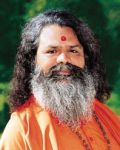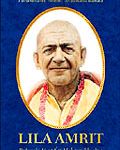The Kumbha Mela in Haridwar 1998
A Report by Mr. G. P. Nagar (Jaipur, Rajasthan)
and Dr. Radha (Vienna, Austria)
On April 3rd, 1998, Paramhans Swami Maheshwaranandaji accompanied by many disciples from Vienna, travelled to India to take part in the last significant spiritual event of this millenium, the Maha Kumbha Mela in Haridwar. This journey was undertaken as the World Religious Parliament (India) wanted to confer on our beloved Gurudev Yogiraj Paramhans Sri Swami Maheshwaranandaji Maharaj, the title of Sarv Bhaum Jagadguru[1] on 10th April, 1998 and the Maha Nirvani Akhara wanted to consecrate him as Mahamandaleshwar[2] on 13th April 1998.
At Indira Gandhi International Airport in New Delhi, hundreds of disciples from all parts of the globe welcomed Swamiji with flowers and garlands. Travel continued by bus to Rohtak for an overnight stay and then onto the first destination of Kurukshetra, where the historical fight of the Mahabharat took place. It was at Kurukshetra God Krishna bestowed the divine wisdom of Sri Bhagavad Gita on his devotee Arjuna.
KURUKSHETRA
Kurukshetra is one of the most important pilgrimage places of India. It encompasses an area of 48 km² with more than 300 sacred sites. Explaining the meaning of teerath (place of pilgrimage), Mr.G.P.Nagar told the foreign disciples that in Satya Yuga, the "Golden Age" of spirituality and mental powers, great Rishis, Yogis and Kings acquired merit by performing tapas, intense austerities, over many years. By their association with them, the places where they performed tapas became full of spiritual radiance and power. These ancient sages knew that in the dark era of ignorance, man's strength of will and spiritual capacity would deteriorate.
Full of compassion for the coming generations, these holy men dedicated the merit of their sadhana to these sacred places, so that whoever visits there shall gain the benefit of their tapas. By the mercy and blessing of these saints, the karmas of the pilgrims are purified, and their consciousness elevated.
By our good luck our dharamshala (guest house) was situated next to one of these sacred places, Suraj Kund (Lake of the Sun God). On its edge there was a Shiva temple in whose grounds we received our meals, prepared and served with loving care and hospitality.
On the following morning, Swamiji and the group took a tour through the area of Kurukshetra and visited several sacred abodes. First we visited the marvellous site of Isthanishwar Temple. Mahant Swami Prabhatpuriji, the head of this temple welcomed Swamiji and the group, and spoke about the importance and meaning of this ancient shrine. The Shiva–Lingam of this temple was placed there by Lord Brahma himself and before the commencement of the Mahabharat war, Lord Krishna and the Pandavas came here to pray for blessing and victory. After we had received prasad we went through the temple. In front of it is a ritual bathing place and a very old tree which is said to fulfil wishes.
From there, Swamiji took the group to Jyotisar Teerath where Lord Krishna conveyed to Arjuna the teachings of the Holy Gita. Swamiji sat under the famous Akhsai Vat (eternal tree) and his disciples gathered around him – deeply touched by holy atmosphere of this place and the meaning of this very moment. We looked out across the wide plain, where many thousands of years ago the glorious heroes of the Mahabharat fought their fateful combat – "Kurukshetra – Dharmakshetra", the battlefield of Kurus and Pandavas was the arena between justice and injustice, where the Lord himself granted victory to righteousness.
We then saw the place where Pitama Bhishma lay on a cot of arrows. When the great patriarch expressed desire for water, Arjuna released an arrow into the earth where a full jet of water sprang forth from the Ganga to quench the thirst of that mighty warrior, who was waiting for the auspicious day of his death.
Our last visit was to Brahmasarovar, a large lake and holy bathing place with a lovely Shiva temple in its midst. Here at this lake, Lord Vishnu rested on on the thousand–headed serpent and out of his navel emerged Lord Brahma, the creator of the Universe.
HARIDWAR
On 7th April, Paramhans Swami Maheshwarananda, accompanied by a group of 250 international disciples, reached Haridwar which is situated on the right side of the sacred river Ganga, at the foot of the Shivalik range of the Himalayas. The river Ganga originates at Gangotri and then reappears for the first time at Haridwar. Since the routes to the sacred Shaiv Shrine of Kedarnath and the equally sacred Vaishnav Shrine of Badrinath pass through this place, it is called Haridwar – Gate of Har or Hari (God).
Here the Ganga flows broadly across several hundred metres, spanned by narrow brigdes. More than 10 km² of the river bank, is covered by makeshift camps of the visitors attending the Maha Kumbha Mela. Millions of pilgrims, lakhs of Yogis, Sadhus, Saints and Spiritual Masters with their disciples have gathered to attend the most auspicious spiritual event in India. Mantras and bhajans sound through thousands of loud–speakers, the fragrance of agarbhati permeates the entire area. Everywhere there is an atmosphere of joyful and solemn radiance.
Historical and mythological background of Haridwar
and the Kumbha Mela
The holiest place in the area is the bathing platform known as Har ki Paori, dotted with Ganga temples. It is believed that here the ascetic King Bharathari fulfilled his "Vairagya" and "Neeti" Sataks, hence the place is named after him. Just nearby is "Brahm Kund" where Brahma is said to have performed tapas and where drops of amrit (nectar of immorality) fell out of the khumb (vessel). Lord Vishnu is reported to have performed tapas at another nearby location called "Vishnu Ghat". Bhagwan Ram performed shradh of his ancestors at Kushavart Ghat. The Pandavas are also said to have performed tapas at Haridwar.
People from distant parts of North India come to immerse the ashes of their dead relatives into the Ganga at Haridwar. It is said that King Bhagirath brought Ganga to Haridwar to ensure the salvation of 60,000 sons of the ancestor King Sagar.
As the places of religious importance in and around Haridwar are too numerous, we can mention only a few: the temple of Mansa Devi at the top of Bilwa hill; the temple of Chandi Devi at the top of Neel hill; the Vaishnav Devi temple; the Bharat Mata temple and the temple of Paradeswar Mahadev whose Linga is of mercury.
Mayapuri is where Daksha Prajapati performed a yagya (ceremony) to which he did not invite his daughter Sati and her husband Shiva. Sati who had gone to the yagya without invitation, was so disappointed about the insult made to her husband, that she emerged herself in the yagya kund. Taking revenge of her self-sacrifice, the attendants of Lord Shiva cut the head of Daksha Prajapati. Distraught at the death of his wife Shiva started to roam with Sati‘s dead body on his shoulders. In order to wean Shiva away from his dead wife, Lord Vishnu cut her body in pieces with his chakra. The pieces fell at 51 places, each of which is a shakti peeth now. King Daksha was subsequently restored to life by Lord Shiva. There is a temple dedicated to him at Kankhal (a district of Haridwar) which is under the supervision of Mahanirvani Akhara.
Kankhal, has more than 100 ashrams belonging to Saints, some of them situated over an area of more than 50,000 square metres.
Rishikesh, is situated at a distance of 23kms from Haridwar. It has nearly 50 ashrams, large and small. Each ashram is managed by Saints or charitable and religious trusts. Not only do they accommodate the swamis, but also pilgrims who come to visit the sacred sites.
The origin of the Kumbha Mela is lost in the hoary past. The Rig Veda and the Puranas make reference to it. Lord Buddha (7th century B.C.) speaks of it as a river festival. According to the Puranas, the devas (gods) and asuras (demons) decided to churn the ocean. Mount Mandakini was used as the churner and Vasuki the huge serpent, was used as a rope. The gods were at the tail and the demons at the head of the said rope. Many things emerged from the ocean.
First of all Goddess Lakshmi appeared and Lord Vishnu made her his consort. Eventually amrit the nectar of immortality poured out, but with it, a deadly poison. Neither the gods nor the devils knew how to be rid of the poison, which was strong enough to destroy the whole Universe. So gods and demons went to Lord Shiva for advice. Shiva took the poison and drank it. By his Yogic power he held the poison in his Vishuddhi Chakra and purified it there. So the poison did not affect him, only his throat became dark blue and from this Lord Shiva earned the name Nilkant (=blue neck).
When the kumbh (vessel) of nectar emerged from the ocean, both gods and demons rushed to take it. God Indra discretely hinted to his son Jayant to run away with the vessel, which he promptly did. The demons chased him and in the fight that followed, a few drops of nectar fell at Brahm Kund, Haridwar, Prayag, Ujjain and Nasik which are situated on the rivers Ganga, Yamuna and Sarasvati, Chipra and Godawari respectively. Since this fight continued for twelve days (and one day in the life of gods equals one year in the life of man), the Kumbha Mela is held at Haridwar, Prayag, Ujjain and Nasik every 12th year. It is also said that the Sun, by its rays, made the vessel of nectar stronger to prevent it from breaking. The Moon, by its gravitational force, prevented the vessel from falling and Lord Brihaspati, by his divine guidance to the gods, prevented the demons from obtaining the nectar.
Therefore a Kumbha Mela is celebrated at Haridwar when the Sun is in Aries and Jupiter in Aquarius. Since Jupiter returns to Aquarius after 12 years, the Kumbha Mela is celebrated after 12 years.
This year the Maha Kumbha Mela started on 14th January and continued up to 27th April 1998. The dates of Shahi Snan (the Royal Bath) were 25th February, 28th March, 14th April and 27th April 1998. Out of these dates, the 14th of April was the most important for 1998. 2,5 million people bathed in the holy river on 28th March and another 10 million bathed on 13th and 14th of April 1998.
But we will return now to the 7th of April and report about our stay in Haridwar from the beginning.
At the time of the Kumbha Mela in Haridwar, many ashrams and institutions secure plots of land with tents and podiums for the visiting pilgrims, over an area of 10,000 to 20,000 square metres. In one such an area at Neel Dhara, a distance of only 200 metres from the Ganga with a beautiful view across to the Mansa Devi temple on the opposite hill, the World Religious Parliament (India) and Brahman International erected 50 tents and a spacious podium for the use of Paramhans Swami Maheshwarananda and his disciples. On our arrival we were blessed with the darshan of Paramhans Swami Madhavanandaji (Holy Guruji), who had come early to the Mela to help prepare the celebrations for Swamiji.
On the next day we made our first visit to Ganga Mata. According to Swamiji's advice, on this day we only dipped in our feet, to gradually open ourselves to the spiritual energies of the Ganga’s holy waters.
In the afternoon dark clouds began to cover the sky. Lightning flashed and a strong wind rose. Eventually the sky became black with thunder and lightning, and a violent cloudburst fell and flooded the camp. After half an hour the rain stopped just at the right time, the rain stopped and we could leave the camp with Holy Guruji and Swamiji and set off to the other side of the Ganga to make a visit to Surad Giri Bangala Sannyas Ashram, Kankhal.
Our beloved Gurudev, His Holiness Paramhans Swami Madhavanandaji Maharaj (Holy Guruji) and his disciple, Yogiraj Paramhans Swami Maheshwaranandaji (Swamiji) were warmly welcomed by the Peetadeshwar of this ashram, Sri Mahamandaleshwar Brahmanand Giriji Maharaj, successor of Sri Mahamandaleshwar Maheshwaranandaji Maharaj. Guests of honour were the successor of Paramhansa Muktananda, Sri Mahamandaleshwar Nityanandaji Maharaj from Sri Muktanand Ashram, Ganeshpuri, Sri Mahamandaleshwar Vishweshwarananda Giriji Maharaj, Sri Mahamandaleshwar Niranjanand Giriji Maharaj and Acharya Mahamandaleshwar Sri Vishwadevanandji Maharaj. As a token of respect a shawl was presented to Holy Guruji, Swamiji and all his disciples.
On the morning of April 9th, we went to the Ganga again and this time we dived in completely. Some prayed, some sang mantras. Each one of us was conscious of the deep signficance and meaning of this moment. From this day on we had the opportunity to take a refreshing and purifying bath in the Ganga every day. Swamiji also payed honour to Mother Ganga and bathed in her waters on the day of the full moon.
The group then had the opportunity to visit the holy site of Rishikesh. Rishikesh is also situated on the Ganga, yet here the valley is more narrow than in Haridwar. Two famous bridges span over the river, Ram Chula and Lakshman Chula. On the banks of the river many picturesque ashrams are established. We visited one ashram in whose wonderful grounds we admired many pictures and statues which brought to life the spiritual and mythological records of ancient India.
The Meeting of the World Religious Parliament on the topic of "The Environment"
On the afternoon of April 9, a meeting of the World Religious Parliament (India), Brahman International and Universal Sanatan Foundation was held in our campus under the chairmanship of Yugacharya Prabhakar Mishra. It was attended by Dharma Chakravarti Paramhans Swami Madhavanandaji, Yagyavalk Jagadguru Swami Vidya Bhaskar Teerath of Karnamath, Jagadacharya Chandra Swamiji Maharaj of Vishwa Dharmaytan (New Delhi), Maharishi Pilot Baba (Paramhans Swami Som Nath Giriji) of Nani Tal, Swami Nijanandji Maharaj, Haridwar, Sri K. C. Agarwal, Secretary of All India Sadhu Parishad, Jagadguru Shankaracharya Adhochjanand, Vidya Chaitana, members and dignities of the World Academy of Ayurveda, Brahman International, Universal Sanatan Dharma Foundation and representatives from 20 countries of the world.
Yugacharya Prabhakar Mishra stated that the World Religious Parliament was founded in 1885 in Chicago at the initiative of Swami Vivekananda. During the centennary celebration of that body in 1995, a decision was made to rejuvenate it and make it an effective body for ensuring mutual understanding between people practising different religions. He told that in the meeting of the Indian Chapter of the World Religious Conference held at Siri Auditorium New Delhi in September 1997, it was unanimously decided to confer on Paramhans Swami Maheshwarananda the title of "Sarv Bhaum Jagadguru" in view of Swamiji‘s outstanding contribution in promoting Universal peace, the teachings of Yoga and propagating Sanatan Dharma in remote parts of the world.
Jagadacharya Chandraswami Maharaj recalled with gratitude his first meeting with Swamiji in Vienna. He profoundly praised him for choosing to work with, and uplift, the suppressed and often persecuted people of Eastern Europe.
Kusum Singh Shivraji from the Netherlands said: "I am very glad that the organisation of the World Religious Parliament gathered us here to express our feelings about Vedic Culture and Indian Philosophy for the upliftment of all Souls. Swamiji Maheshwarananda confers spiritual light on those who desire to elevate themselves to a divine level. We should see God the Almighty in every living being, not only human being,s but all living beings. My submission on this occasion is to realize OM Satya Sad Gamaya."
Jagadguru Swami Vidhya Bhaskar Teerath and Swami Vidya Chaitanya also gave their thanks to Chairman Acharya Prabhakar Mishra and paid hommage to Paramhans Swami Madhavanandaji as a pioneer of many swamis. And they praised Paramhans Swami Maheshwarananda who spread the message of "Yoga in Daily Life" throughout the world.
Paramhans Swami Maheshwaranandaji's inauguration as Sarvabhaum Sanatan Dharma Jagadguru
On 10th April, 1998, the first of the solemn celebrations for which we had undertaken this journey took place – the inauguration of Paramhans Swami Maheshwaranandaji by the World Religious Parliament as "Sarvabhaum Sanatan Dharma Jagadguru".
Personalities who attended this function were: Vaid Nanak Chand, President of the World Academy of Ayurveda (Delhi), Padmi Sri Dronacharya Guru Hanuman, Jagadguru Ramanandacharya Sri Ram Bhadracharya of Chitrakoot, Yagyavalk Jagadguru Vidhya Bhaskar Teerath, Sri Mahamandaleshwar Balkrishna Yati ji Maharaj, Varanasi, Dharma Chakravarti Paramhans Swami Madhavanandaji, Bharat Gaurav Ram Baba of London, Kusum Shivraj Singh of Holland and prominent disciples of Swamiji from 20 countries. Present were also numerous representatives from press, tv and radio, correspondants of diverse medias, delegates from humanitarian and spiritual organisations.
Admidst the chanting of Vedic mantras, yagya and havan, the holy puja was performed and water from 25 different rivers of the country was used in the abhisekh (coronation) with the royal turban. Then Yugacharya Prabhakar Mishra, President of Universal Sanatan Foundation and World Religious Parliament (India) solemnly proclaimed Paramhans Swami Maheshwarananda as "Sarvabhaum Sanatan Dharma Jagadguru" much to the delight of all assembled persons.
After his coronation Sarvbhaum Sanatan Dharma Jagadguru Paramhans Sri Swami Maheshwaranandaji addressed the auditory with words of blessing: "OM Gurur Brahma, Gurur Vishnu, Guru Devo Maheshwarah Gurur Sakshat Parabrahma, Tasmey Sri Guruve Namah – Sanatan dharma adi anadi dharm hain. Sanatan Dharma means eternal dharma, eternal duty, religion and relationship. Religion is closely related to "realize" – realize your relation, your true relatives, your position within nature and the Universe. Realize your unity with God and all living beings. Religious and spiritual practices have built the fundamental background of daily life in India. Spiritual dharma does not mean to withdraw from the world, on the contrary, it means to come closer to mankind. There is no wish to convert anybody but rather to convince people by living a good example. Therefore many saints and yogis have travelled to other parts of the world to share the message of spiritual truth and unity to all humankind. We want to show people a path to physical, mental, social and spiritual healing. A path which leads to the highest goal, God–realization.
I thank the World Religious Parliament for the great honour which they conveyed upon me and I pray to the Almighty Lord to grant me the right thoughts and acts for this position, to spread the light of Sat Sanatan Dharma and the eternal values of spiritual Truth all over the world. Especially I convey my thanks to the President of the World Religious Parliament, Brahmrishi Acharya Prabhakar Mishra for his ceaseless work and efforts in the service of mankind. I pray for his health, long life and God's blessing for his further activities. But before all I wish to give my humble Pranams and deepest gratitude to my beloved Gurudev Paramhans Swami Madhavanandaji, that he has lead me to this high position."
Then, as a sign of his reverence, Swamiji laid down the royal turban to the lotus–feet of his Master.
As per desire of the President of World Religious Parliament, Sarvbhaum Sanatan Dharma Jagadguru Paramhans Swami Maheshwarananda bestowed the title of "Sanatan Dharma Mahamandaleshwar" on Siddha Baba of Allahabad, Sant Swami Parmanandaji of Haiderabad and Swami Ram Krishna Das ji of Morena. He also bestowed the title of "Vishwa Gaurav" (Glory of the Universe) on Yogeshwar Paramhansa Swami Adgadanandaji and Jagadguru Ramanandacharya Sri Ram Bhadracharya of Chitrakoot. Twenty-three persons from India and other countries received the titles of "Brahm kul Bhusan" (Jewel among Brahmins) and "Bharat Gaurav" (Glory of India).
Paramhans Swami Maheshwaranandaji's inauguration as Mahamandaleshwar of Maha Nirvani Akhara
The 13th of April, 1998 turned out to be a very exciting and memorable day. As it was Bausakh Poornima, and the 14th April was the holiest day to dip into the river Ganga, people started to pour in by the millions. All vehicle traffic around the city was closed, so we had to reach the chawni (cantonment) of Maha Nirvani Akhara on foot, where Paramhans Swami Maheshwaranandaji was to be coronated as Mahamandaleshwar. With the chanting of Vedic mantras, Swamiji performed puja, following the directions of the pandits. According to sacred tradition, he received abhishekh tilak and abhishekh kalash.
Subsequently, Swamiji was taken to a very spacious and high platform, adorned with the presence of dozens of Mahamandaleshwars, Mahants, Secretaries of akharas and the head Priests of many temples.
After Swamiji was formally declared a Mahamandaleshwar by the Secretary of the Mahanirvani Akhara, all the Mahamandaleshwars, Mahants, Saints and Pandits greeted him and wrapped shawls around his shoulders as a token of their blessing. Following this, the disciples of Paramhans Swamiji also offered him shawls and gifts to commemorate his coronation as Mahamandaleshwar. Nearly four hundred shawls were presented to Swamiji.
The Secretary of the akhara highlighted the prominent role carried by Swamiji in propagating the eternal values of Sanatan Dharma and Yoga in Daily Life in the different parts of the world. Sri Mahamandaleshwar Swami Niranjananda Giriji, who has visited many foreign countries, acquainted the audience with the Swamiji’s activities worldwide and welcomed his coronation as Mahamandaleshwar.
The Peetadeshwar Acharya (head of the akhara) Mahamandaleshwar 108 Sri Swami Vishwadevanandji spoke of the time honoured, high tradition of the akhara, and said that in Swamiji Maheshwarananda, the akhara was now going to have a Mahamandaleshwar who is as proficient in speaking English and German as he is in speaking Hindi. He added that Swamiji would prove a great asset to the akhara and widen the sphere of its activities.
His Holiness Sri Mahamandaleshwar Paramhans Swami Maheshwarananda Puriji Maharaj thanked all the assembled Saints, Scholars and Mahamandaleshwars, and assured them that he would live and work according to the traditions of the akhara, and continue the spiritual and humanitarian work he has embarked upon under the inspiring guidance of his Guru. Dharma Chakravarti Paramhans Swami Madhavanandaji also thanked the Acharya and other Mahamandaleshwars for receiving Swamiji into their fold, and affectionately recalled many incidents from Swamiji‘s early life which had convinced him of his great genius and dedication to religion. After the coronation ceremony, Swamiji and his disciples were honoured guests at luncheon hosted by Mahamandaleshwar Niranjanpuri Giriji of Jullundar.
We all felt abundantly blessed to have the opportunity to take part in the Maha Kumbha Mela at Haridwar, and in the glorious celebrations and inaugurations of our beloved Gurudev Yogiraj Paramhans Sri Swami Maheshwaranandaji Maharaj as Sarvabhaum Sanatan Dharma Jagadguru and Mahamandaleshwar, by which his life’s work and his unceasing, devoted service to humankind has been honoured and crowned, in spreading the Light of the Almighty Lord Bhagwan Sri Deep Narayan Mahaprabhuji and the message of "Yoga in Daily Life" all over the world.
We pay our humble respects, devotion and salutations to our Satgurudev Yogeshwar Sri Devpuriji, Ashram Kailash, Bhagwan Sri Deep Narayan Mahaprabhuji, Bari Khatu, and His Holiness Paramhans Swami Madhavanandaji Maharaj, Ashram Jaipur, Jadan and Nipal, whose blessing gave us the opportunity to be present at these holy events.
The memories of our stay at Haridwar during the Maha Kumbha Mela of 1998 will be cherished by all for a long time.
Historical backgrounds of the Akharas
Readers might be curious to know something about the institution of akharas and the sacred peeths established by Adi Shankaracharya.
Adi Shankar had four principal disciples – Padampad, Hastamalak, Sureshwar and Trotak. He founded the four peeths – Jyotir Math in the North, Shringeri Math in South, Govardhan Math in Jagannath Puri in East and Sarada Math in the West and made each of his four disciples their head. The disciples of Hastamalak (Govardhan Math, Jagannath Puri) write "Van" and "Aranya" after their names. The disciples of Sureshwar (Jyotir Math, Badri Math) write "Giri", "Parvat" and "Sagar" after their names. The disciples of Trotak (Shringeri Math) write "Puri", "Bharthi" and "Sarasvati" after their names. Thus, all sannyasis used either of these surnames and this gave birth to the institution of Dasnami (ten names) among the sannyasis. The principal Shaiva subsect established by Shankara, the "Dasnami" sannyasis, are known as Vedic Shaiva. Integrated to the monastic order are the nagas. Dasnamic ascetics have been divided into two categories, (a) those who hold the scriptures viz Shastradhari and (b) those who hold arms viz Astradhari.
During the invasions of Mahmud Gazuri, Mohammad Ghori and Taimur, thousands of Hindu temples were levelled to the ground, and millions of Hindus killed. Things were no better during the Muslim rule in India. Realizing the dangers of oppression and persecution of the votaries of Sanatan Dharma by fanatics and aggressors of other denominations, Adi Shankara realized that spiritual power alone was not sufficient. He insisted upon the younger sadhus to build up muscle power by doing physical exercise and acquiring proficiency in the use of weapons. As such, the maths where such exercises were conducted, came to be known as "akharas" (wrestling places).
Adi Shankara advised the akharas to resist by force, if necessary, the persecution of Hindus and the desecration of their sancutaries. During the Muslim invasions and the Muslim rule, these akharas acted as barriers against attacks on Hindu people, their sacred shrines and institutions. On many occasions, armed members of the akharas valiantly resisted the persecution of the Hindus and desecration of temples. Not infrequently, rulers sought the help of naga soldiers in their war. They have the glorious record of having fought many battles and at times the numerical strength of particular akaharas ranged up to 40,000. After India's independence, these akharas lost their militant character and their Saints have been vigorous in preaching and propagating the eternal values of ancient Indian culture and philosophy.
There are 13 akharas in Haridwar each of them head by a highly revered Saint having a number of Mahamandaleshwars. Most of them have their own ashrams outside Haridwar and their own disciples.
The oldest akhara – Atal Akhara, was founded in 646 A.D. in Gondwana. In the 17th century Rajendra Giri of this akhara captured 114 villages in Jhansi U.P. This akhara was revitalised in 1704 A.D. and its principal seat is Patan though it has an ashram at Kankhal. The present head of the akhara is Acharya Sri Mahamandalweshar Mangalanand Giri.
Maha Nirvani Akhara is an off-shoot of Atal Akhara. On being denied prasad of Gajanandji seven sadhus of Atal Akhara left it and commenced tapas at Gangasagar. They had darshan of Kapil Muni and with his blessings, they established an akhara in 748 A.D. near Neel Dhara in Haridwar. In the year 1260, 22,000 naga Saints, led by their spirited leader Mahant Bhavanand Giri, liberated Kankhal from Muslim aggressors and the present akhara is exactly at the place where they hoisted their first flag. This akhara owns the Daksheswar temple and its present head is Acharya Sri Mahamandaleshwar Vishwadevanand.
Paramhans Sri Swami Maheshwaranandaji Maharaj has become a Mahamandaleshwar of this akhara on April 13, 1998.
Avahan Akhara was established in 646 A.D. and reorganized in 1603. The main seat of this akhara is Dasamegh Ghat of Varanasi. It also has an ashram at Rishikesh. Swami Anupgiri and Umrao Giri of this akhara were famous warriors. The present Acharya is Sri Mahamandaleshwar Swami Shivendra Puri.
Anand Akhara was established in Berar (in Madhya Pradesh) in 855 A.D. and its main centre is in Varanasi, though it has an ashram in Haridwar. Its Acharya is Mahamandaleshwar Devanand Sarasvati.
Niranjani Akhara was established in Mandvi (Gujarat) in 903 A.D. Its main centre is in Daranganj Allahabad. It has a beautiful ashram at Dam Kothi in Haridwar. Mansadevi and Vilvakesar temples of Haridwar belong to this akhara. Its present Acharya is Sri Mahamandaleshwar Punyanand Giri.
Juna Akhara is also called Bhairav Akhara. It was established in 1145 A.D.in Karan Prayag of Uttarkhand. Its main centre is Mara Hanuman Ghat of Varanasi. Its ashram in Haridwar is near Mayadevi temple which it owns. Its Acharya is Sri Mahamandaleshwar Lokeshanand Giri.
Agni Akhara was established in 1136 A.D. Its Acharya is Sri Mahamandaleshwar Swami Prakashanand Maharaj.
The above named seven akharas are of Naga Saints. Apart from these, there are two akharas of Udasin Sampradaya – Bara Udasin Akhara and Udasin Naya Akhara, one Nirmal Akhara and three Akharas of Vaishnav Bhairagi Sampradaya – Digambar Ani Akhara, Panch Ani Akhara and Nirmohi Ani Akhara.
On the occasion of Shahi Snan (the Royal Bath) of Maha Kumbha Mela, Mahamandaleshwars, Mahants, Acharyas and the heads of all these 13 akharas, proceed in well decorated processions, to bathe at Hari ki Pauri. Their turn for the holy bath are fixed. In the Kumbha Mela, members of the Niranjani Akhara along with its associate Anand Akhara are the first to bathe. They are followed by the members of Juna Akhara. The members of Avahan, Agni, Atal and Mahanirvani Akhara bathe in the third lot on the day of Shahi Snan.
[1] Sarvabhaum Jagadguru means the “Spiritual Master of the whole Universe”
[2] Mahamandaleshwar =religious title comparable to the rank of an Archbishop
Next Chapter: The Spiritual Heritage of Paramyogeshwar Sri Devpuriji
Previous Chapter: Paramhans Yogiraj Swami Maheshwarananda
Overview: Vishwaguru Mahamandaleshwar Paramhans Sri Swami Maheshwarananda







